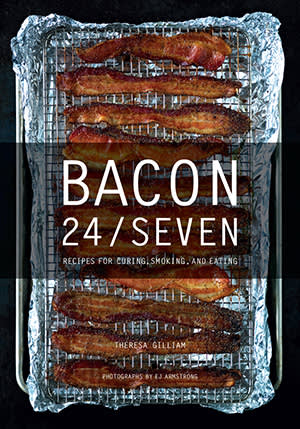PicMonkey is thrilled to present these food photography tips from EJ Armstrong, food photography guru and fellow super cool Seattleite. Her book, Bacon 24/7, is at Barnes & Noble and on Amazon.

This year we published our book Bacon 24/7, a folder of unique recipes for morning, noon and night, using everyone’s favorite savory ingredient. Bacon is not the easiest to shoot. Like all successful food photography, it requires the right equipment, perfect lighting, attention to detail, and of course a willingness to get a little messy. So here are a couple tips from the making of our book to help you get the shot that sizzles.
1. Have the right hardware The right equipment is the stuff you already own, plus a couple inexpensive extras – I would recommend a tripod, a white reflector card and a black card to deflect light and create shadows. Other than that, use what you have. And of course, natural light.
2. Make light work for you I was trained in classical art history, so I spent a lot of time studying how the masters lit their subjects. My advice would be: if you’re using natural light, go with what looks pleasing to you. Top-back is often something I use as a standard, but there are all kinds of ways to use light – side lighting, double-front lighting, etc. Try different ways, and experiment until you get the results you want.
3. Be smart about your props Props can make or break a shoot. Bacon 24/7 is a perfect example of this. From the get-go, we decided that we were going to have a very simple, masculine style that included dark metals, natural things, clunkier pots, and heavier dishes throughout the book. We went through each shot, making sure it flowed harmoniously into the rest of the series. You don’t want your style to be all over the place. This project has a darker tone because the audience isn’t necessarily the Martha Stewarts. We were going after the Esquire guy who cooks.
4. Know your angles In Bacon, there were certain angles that worked better than others. Everyone’s doing overhead shooting these days – and you know, it looks great, nothing wrong with it – but it doesn’t work for everything. If you’re shooting a sandwich, you kind of need to get in there and see what’s in it. What you want to do is assess the situation and do whatever you need to flatter the subject. For me, I had to get up close and personal with my bacon.

5. Find a balance The whole photo is made up of your lighting, your subject matter and your props. Finding the balance where all three are working together is really, really important. I think everyone can more-or-less have a natural eye for what works and what doesn’t, but if you don’t, go pick up a book on Art History 101 – in it will be every standardized use of edge, line, division and balance in an image. Painting and photography are really not that different.
6. Shoot a lot Food often requires more than a one-and-done shot. Few people can get it right the first time (it took me ten years), so be prepared to take hundreds of photos to get it right. There’s a difference between making a nice photo and getting the best shot, the more you shoot, the more consistent you’ll get – that’s what really makes a great photographer.
7. Get out of your head and embrace a little mess Once the food is out there, you better shoot it quick. Waiting around to try and make it perfect, trying to add grease to make it shine a certain way can be a mistake. A lot of people get caught up in making “perfect food”, and when they make “perfect food” it looks like hell. Food isn’t perfect – it’s a natural, organic substance. You really just have to find what’s appetizing to you. And if you’re working on a project or a folder like the Bacon book, decide on a style; prop for it, light for it, give yourself parameters to work in, but don’t strive for perfection. Perfect looks plastic. Let the food be food.

EJ is the founder of Armstrong Pitts Studios, a Seattle photography studio specializing in commercial food, beverage, food lifestyle, culinary short film and book publishing. Her clients include Starbucks, Whole Foods, Darigold and Tyson to name a few. With over thirty years of experience, her beautiful food imagery is what she has become well-known for world-wide. Brilliant and ballsy, her talent and insight is invaluable to the studio’s philosophy of what true beauty is. Visit our website and our blog to learn more.
